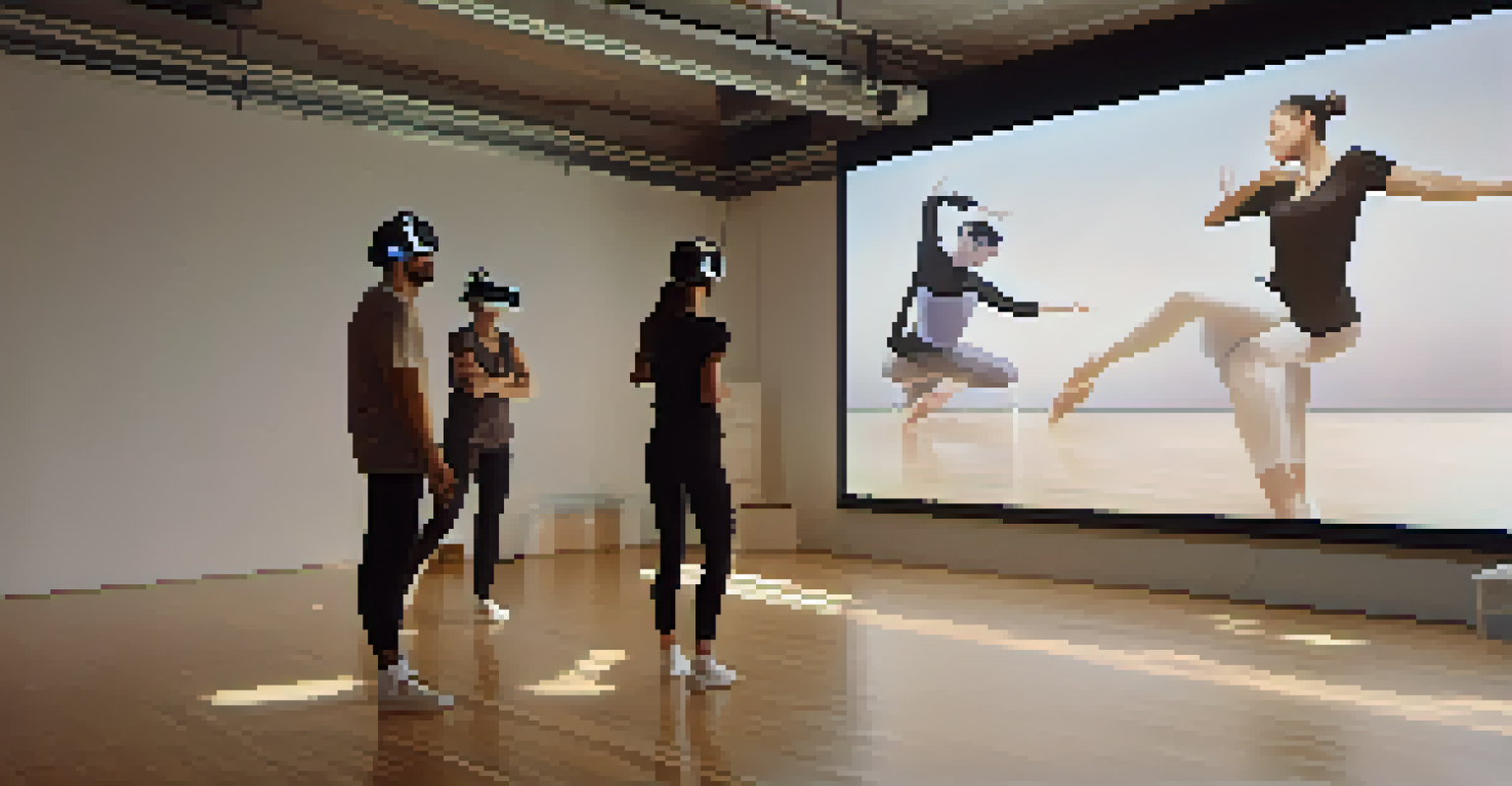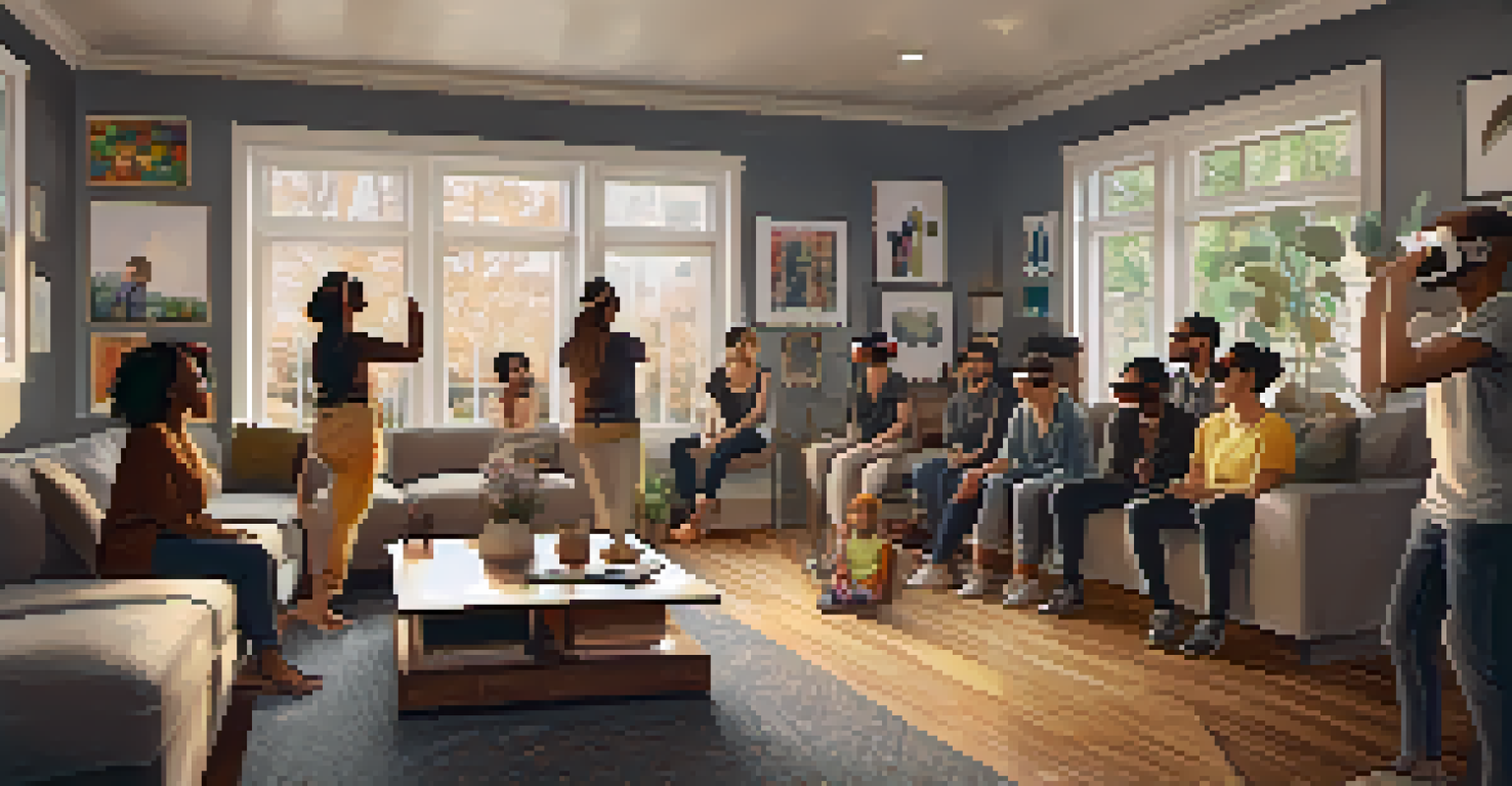Enhancing Dance Performances with Immersive VR Technologies

The Evolution of Dance: From Stage to Virtual Reality
Dance has always been a transformative art form, evolving with technology. In recent years, we’ve seen a shift from traditional performances on stage to immersive experiences that incorporate virtual reality (VR). This evolution allows dancers to reach audiences in new ways, transcending the physical limitations of a theater space.
Dance is the hidden language of the soul.
Imagine a dance performance where viewers can choose their perspective, moving around the dancers as they perform. This brings a level of interactivity that engages the audience far beyond a standard viewing experience. With VR, the boundaries of creativity are pushed, allowing for storytelling that was previously unimaginable.
As we embrace these technologies, it’s crucial to consider how they can enhance the emotional connection between performers and their audience. By immersing viewers in the dance, we can evoke deeper feelings and create lasting memories, making dance not just a performance, but an experience.
How VR Technology Works in Dance Performances
At its core, VR technology creates a three-dimensional, computer-generated environment that users can explore. Dancers can perform in front of cameras that capture their movements, which are then translated into a virtual space. This allows for a seamless blend of physical and digital art forms, creating a unique presentation.

For instance, choreographers can design intricate digital landscapes that respond to the dancers’ movements. If a dancer jumps, the virtual environment might ripple or change colors in response. This synchronization captivates audiences and transforms the way we perceive dance as an art form.
VR Enhances Dance Accessibility
Virtual reality bridges geographical and physical barriers, allowing global audiences to experience dance performances from home.
Moreover, VR technology can also incorporate elements of augmented reality (AR), where digital images enhance the physical world. This combination allows for even more creative expression, as dancers can interact with both real and virtual elements, creating a truly immersive performance.
The Benefits of Using VR in Dance Performances
One of the most significant advantages of VR in dance is accessibility. With traditional performances, not everyone can attend in-person due to geographical or physical constraints. VR can bridge this gap, allowing people from all over the world to experience a dance performance from the comfort of their homes.
Technology is best when it brings people together.
Additionally, VR offers dancers opportunities for collaboration that were previously difficult to achieve. Artists from different parts of the globe can work together in a virtual space, sharing their movements and ideas in real-time. This fosters creativity and innovation, leading to a richer dance experience.
Furthermore, the immersive nature of VR can enhance audience engagement. Viewers are not just passive observers; they become part of the performance, which can lead to a more profound appreciation for the art form. This interactive experience can inspire future generations of dancers and audiences alike.
Creating Unique Choreography with VR Tools
Choreographers now have access to various VR tools that allow them to visualize and experiment with their creations before ever stepping onto a physical stage. These tools can simulate how movements will look in a virtual environment, enabling artists to refine their work in real-time.
For example, a choreographer can create a digital avatar that mimics the movements of a dancer. By adjusting the avatar's movements within the VR space, they can see how changes affect the overall choreography. This iterative process not only saves time but also encourages experimentation.
Innovative Choreography Tools
Choreographers can utilize VR tools to visualize and refine their work in real-time, fostering creativity and experimentation.
Moreover, these tools can help in teaching and mentoring young dancers. By using VR, instructors can demonstrate complex movements in a way that is engaging and easy to understand. This hands-on approach can be particularly beneficial for visual learners, making dance more accessible to all.
Challenges and Limitations of VR in Dance
While VR offers exciting possibilities, it also presents several challenges. One of the main concerns is the technology itself. Not everyone has access to high-quality VR equipment, which could limit audience reach and engagement. Ensuring that performances are accessible to a wider audience remains a significant hurdle.
Additionally, there’s the issue of creating a truly immersive experience without isolating the dancers from the physical world. Striking the right balance between virtual and physical elements is essential for maintaining the essence of dance as a communal experience. Too much reliance on technology can sometimes detract from the raw emotional connection inherent in live performances.
Finally, as with any new technology, there’s a learning curve. Dancers and choreographers must adapt to using VR tools effectively. This requires training and practice, which can be time-consuming. However, as artists become more familiar with these technologies, we may witness a new wave of creativity in the dance world.
Case Studies: Successful VR Dance Performances
Several innovative companies and artists have already embraced VR in their dance performances. For instance, the acclaimed dance company, The Royal Ballet, launched a VR experience that allows audiences to step into their world. Viewers can virtually attend a rehearsal, gaining unique insights into the artistry behind the scenes.
Another example is the collaboration between dancers and video game designers, leading to performances that blend gaming and dance. These productions often utilize real-time motion capture, allowing dancers to interact with a digital environment dynamically. This fusion not only captivates audiences but also expands the definition of what dance can be.
Balancing Virtual and Physical Dance
While VR offers immersive experiences, it is essential to maintain the emotional connection of live performances to preserve the essence of dance.
These case studies highlight the potential of VR technology to create groundbreaking, engaging performances. As more artists experiment with these tools, we can expect to see an exciting evolution in how dance is presented and experienced.
The Future of Dance in an Immersive VR World
As we look ahead, the future of dance in a VR landscape appears promising. We can anticipate a growing number of performances designed specifically for virtual environments, pushing the boundaries of creativity and expression. This shift could redefine how audiences engage with dance, making it more interactive and inclusive.
Moreover, the integration of AI in VR could further enhance dance performances. Imagine a virtual dancer that learns and adapts to a choreographer’s style, creating unique collaborations. This blending of technology and artistry opens up new avenues for exploration and innovation in dance.

Ultimately, as technology continues to evolve, so will the art of dance. Embracing immersive VR not only enriches the performance experience but also ensures that dance remains a vibrant and relevant art form in our increasingly digital world.